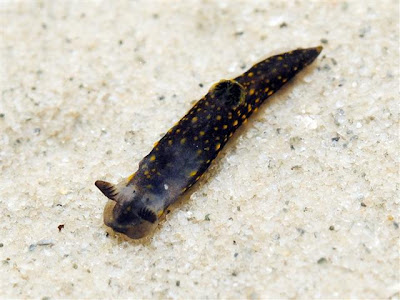It has been almost 6 years since the fateful mass mortality event that occured in Chek Jawa. My first visit to this special shore was exactly on the date that we witnessed the mass death.
Despite not having to see how the shore was like in the past, many stories, accounts and photos did the job for me to compare the shore before and after the heavy rains in December 2006 and January 2007.
Going down to the shore with Teamseagrass has allowed me to check out how the shore is doing, especially after the monsoon season. I am glad to see that many of the Carpet anemones (Stichodactyla haddoni) in the northern shore are still doing well! No signs of bleaching or uprooting.
Here's a view of the southern shore with the huge carpet anemones among the seagrass lagoon.
Many of the carpet anemones also are found on sandy substrates such as those in the photo collage above. There seems to be more carpet anemones than my previous trip one year ago!
Here's a different perspective of the carpet anemones with their photos taken using an underwater camera.
Interestingly, I witnessed how an unfortunate crab which happened to swim across a carpet anemone got stung and slowly was brought towards the centre of the oral disk where the mouth and stomach is located. It really worked like a conveyor belt.
It is heartening to still see dugong feeding trails on Chek Jawa. In fact, we have also seen them on various shores of Changi.
During low tide, shore birds such as these terns rest and feed on the large expanse of shore exposed. At the background is Pulau Tekong.
Among the many critters that the birds feed on would be these circular stuffs... What are they?
These are actually Cake sand dollars (Arachnoides placenta) found buried slightly underneath the sand. The cake sand dollars are still found in abundant numbers on the shore... this is a good sign that the recent rain did not affect the marine life significantly.
On one of the sand dollars, I managed to find a parasitic snail preying on the echinoderm.
How about other soft-bodied invertebrates that would respond poorly to very low salinity, such as the sea cucumbers? Apparently, many of the sea cucumbers such as this Garlic bread sea cucumber (Holothuria scabra) look fine.
Here is an assortment of the different types of sea cucumbers encountered on the trip.
What is slightly worrying would be that this trip was the first time I saw so many Warty pink sea cucumbers (Cercodemas anceps) on Chek Jawa and that some of them seem to be decomposing. This could be a response to the recent rains in which salinity was lowered to a certain limit that these sea cucumbers start to deteriorate.
Nevertheless, the other marine organisms were alright. So it was not alarming for us.
Due to the scorching sun, I did not find any of the usual sea stars except for this uncommon Luidia sand star (probably Luidia hardwicki).
I couldn't find the huge numbers of Button snails (Umbonium vestiarum) that can be found on the sandy shores of Chek Jawa. Nevertheless, I managed to stumble on one live individual. Hopefully more can be found elsewhere.
With Chay Hoon's microscopic eyes, she found this tiny Tiny black gymnodoris nudibranch (Gymnodoris sp.)! This is probably my first sighting of this nudi on Chek Jawa.
A washed up Ball flowery soft coral was found just right beside one of the boardwalk pillars.
And in it, there's a little colourful brittlestar!
The boardwalk legs are well encrusted with many types of living organisms such as sponges and ascidians.
A quick look at the rocky shore revealed the usual assemblage of rocky marine life such as this Blue-spotted flatworm (cf Pseudoceros indicus).
Ending off the quick look of Chek Jawa, I took my underwater camera for a dip again to look at the lush seagrasses of the shore.
The seagrass habitat is a great haven for carpet anemones....
and also Cerianthids (Order Ceriantharia).
Animals wise, I also found a Noble volute (Cymbiola nobilis)...
and even a huge Razor clam (Family Solenidae).
The seagrasses in the lagoon are doing very well despite the shifting sands of the ever dynamic sandbar. Here's a photo with our intrepid Teamseagrass volunteers in action.
According to the latest 7 million population Land Use Plan, Chek Jawa may not exist for long and we may once again face the threats of losing it forever.
From Ria's blog post, the plans in the north include a road link from the mainland jumping off at Punggol, crossing to Pulau Ubin through Chek Jawa to jump off to Pulau Tekong before circling back to the mainland on Changi East. Proposed reclamation (in yellow) will bury Pasir Ris shores, Pulau Sekudu and Chek Jawa as well as a large amount of shore at Changi Beach.
What can one person do about this?
Visit our shores before they are gone. Join nature activities at our wild places, like those listed on wildsingapore happenings. Share what you've seen. Volunteer for them.
----------
More photos of the trip here: http://www.flickr.com/photos/koksheng/archives/date-taken/2013/01/27/

























